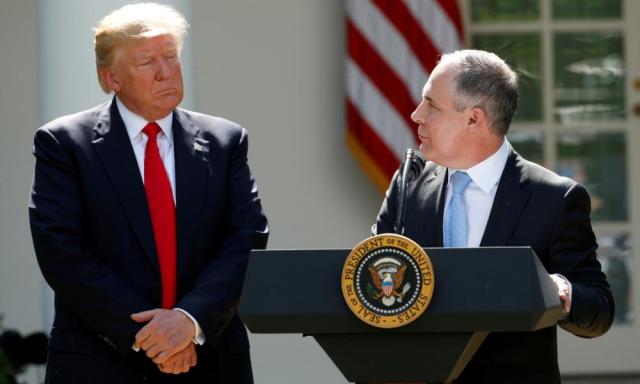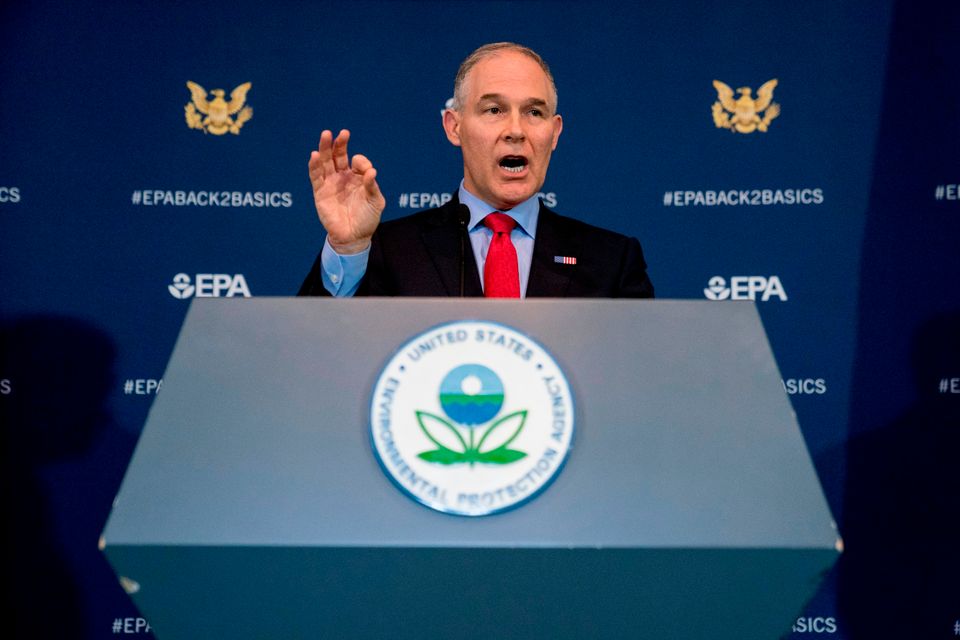ThinkProgress
Trump officials went on a taxpayer-funded shopping spree. Here’s the bill.
Well over $3 million and counting.
Adam Peck April 24, 2018

Last week, U.S. Trade Representative Robert Lighthizer joined the cabal of cabinet-level officials from the Trump White House who have to defend themselves against charges of misusing taxpayer dollars for his own benefit.
The New York Post discovered that Lighthizer had authorized nearly $1,000,000 in spending to renovate two of his Washington, DC offices on the taxpayer’s dime. That figure included a 30-inch, $859 plaque emblazoned with the words “Executive Office of the President,” 90 office chairs billed at $600 apiece, and a $3,500 antique desk for himself.
Lighthizer, Donald Trump’s top general in his Great Trade War of 2018, defended the exorbitant spending in the most Republican way imaginable: he blamed President Obama.
“The furniture purchases are the culmination of a longtime, planned project that began under the Obama Administration to replace two-decade-old furniture,” read a statement issued by Lighthizer’s office. “Laughable,” was what one former Obama administration official said in response. Combined, the past two Trade Representatives spent less than half of what Lighthizer’s office spent during the same period of time.
But Lighthizer’s spending got us thinking. Donald Trump filled his cabinet with a who’s who of multi-millionaires (and the occasional billionaire) and yet several of them have spent hundreds of thousands of taxpayer dollars for private flights overseas, lavish furniture for their offices and residences, and the occasional soundproof phone booth.
Here’s a quick look at the creative and extravagant ways these millionaires have spent your money (so far).


EPA Administrator Scott Pruitt has been dogged by similar accusations of exorbitant spending for months. His office shelled out over $40,000 for the purchase and installation of a soundproof phone booth for his office, more than $2,000 for two desks for his office (after his initial request for $70,000 was denied), and an additional $2,460 to repair the door to his deeply discounted apartment, which was busted down after his security detail grew concerned he was unconscious and in need of medical attention. Turns out he was taking a nap.
Pruitt also spent more than $150,000 on first class flights, an expenditure he defended by claiming to be the target of constant, unnamed threats. “Look, there have been incidents on planes. There have been incidents in airports, and those incidents, you know, occurred, and they are of different types,” Pruitt eloquently told CBS News earlier this year. “These threats have been unprecedented from the very beginning, and the quantity and type are unprecedented.” It’s unclear just how recognizable Scott Pruitt thinks he is to the general public, though judging by how many of you didn’t realize the photo above is a stock image of “caucasian politician” and not, in fact, Scott Pruitt, the answer is: not very.
What’s not included in this total are things like questionable salary expenses. Take Consumer Financial Protection Bureau Director Mick Mulvaney. From his days in Congress, Mulvaney has sought to abolish the CFPB, arguing the agency tasked with protecting taxpayers from predatory financial institutions is a federal boondoggle. During the most recent budget process, he submitted a request for zero dollars for the agency, arguing it was their duty to be “responsible stewards of taxpayer dollars.” Instead, he hired at least eight people to work at the CFPB, half of whom have annual salaries in excess of $250,000, more than $100,000 above the top salary allowed under the federal government pay scale.



 Photo: Richard Tsong-Taatarii, AP. In this Aug. 21, 2017, file photo, automated welding takes place as sections of the replacement Enbridge Energy Line 3 crude oil pipeline are joined together in Superior, Wis. An administrative law judge … more
Photo: Richard Tsong-Taatarii, AP. In this Aug. 21, 2017, file photo, automated welding takes place as sections of the replacement Enbridge Energy Line 3 crude oil pipeline are joined together in Superior, Wis. An administrative law judge … more Modal Trigger. The Ocean Cleanup.
Modal Trigger. The Ocean Cleanup. Modal Trigger. The Ocean Cleanup.
Modal Trigger. The Ocean Cleanup. Modal Trigger. The Ocean Cleanup.
Modal Trigger. The Ocean Cleanup. The majority of it is made up of “ghost gear”: parts of abandoned and lost fishing gear, including nets and ropes, often from illegal fishing boats.
The majority of it is made up of “ghost gear”: parts of abandoned and lost fishing gear, including nets and ropes, often from illegal fishing boats. Environmental Protection Agency Administrator Scott Pruitt speaks to the press at a news conference at the EPA on April 2, 2018 in Washington, D.C. Credit: Jason Andrew/Getty Images
Environmental Protection Agency Administrator Scott Pruitt speaks to the press at a news conference at the EPA on April 2, 2018 in Washington, D.C. Credit: Jason Andrew/Getty Images

 President Trump listens to EPA Administrator Pruitt after announcing decision to withdraw from Paris Climate Agreement in the White House Rose Garden in Washington. Photograph: Kevin Lamarque/Reuters
President Trump listens to EPA Administrator Pruitt after announcing decision to withdraw from Paris Climate Agreement in the White House Rose Garden in Washington. Photograph: Kevin Lamarque/Reuters In this April 3, 2018, file photo, Environmental Protection Agency Administrator Scott Pruitt speaks at a news conference at the EPA in Washington. New internal documents say a sweep for hidden listening devices in Pruitt’s office was shoddy and wasn’t properly certified under U.S. government practices (AP Photo/Andrew Harnik,
In this April 3, 2018, file photo, Environmental Protection Agency Administrator Scott Pruitt speaks at a news conference at the EPA in Washington. New internal documents say a sweep for hidden listening devices in Pruitt’s office was shoddy and wasn’t properly certified under U.S. government practices (AP Photo/Andrew Harnik, Credit: Saving water – clean natural environment – ocean campaign concept with collaborative woman’s hands in droplet shape on blurred wavy clean water background: Love earth, save water – conceptual idea picture.
Credit: Saving water – clean natural environment – ocean campaign concept with collaborative woman’s hands in droplet shape on blurred wavy clean water background: Love earth, save water – conceptual idea picture. Family Holding Earth in their hands -Earth Day. NASA Image
Family Holding Earth in their hands -Earth Day. NASA Image All adults and children should eat more fruits and vegetables, whether they are organic or conventionally grown. With
All adults and children should eat more fruits and vegetables, whether they are organic or conventionally grown. With 

